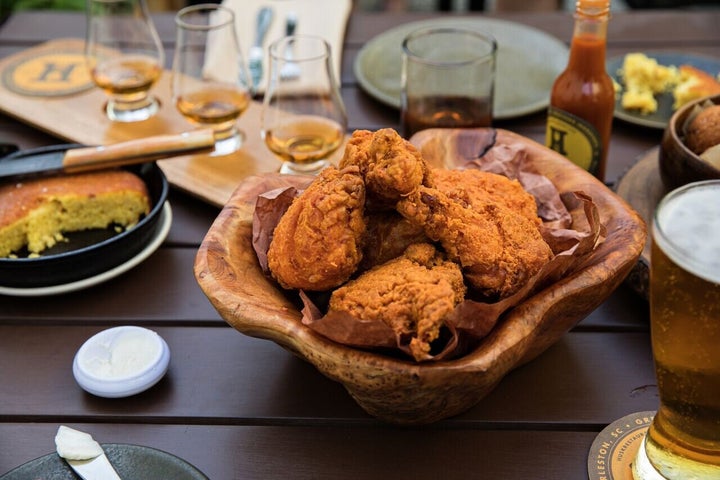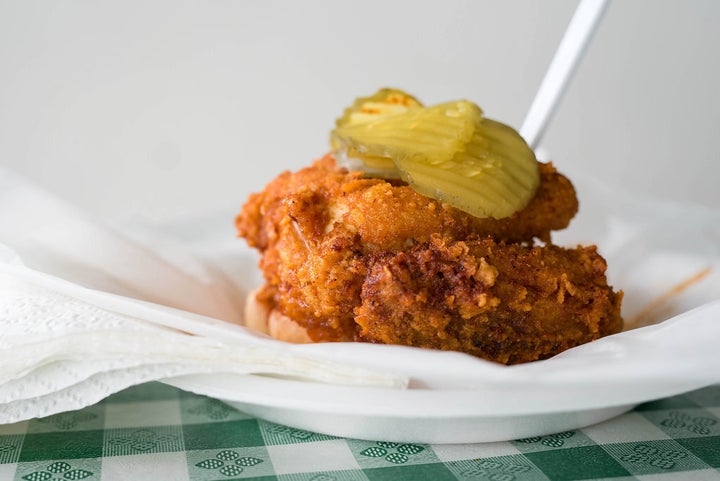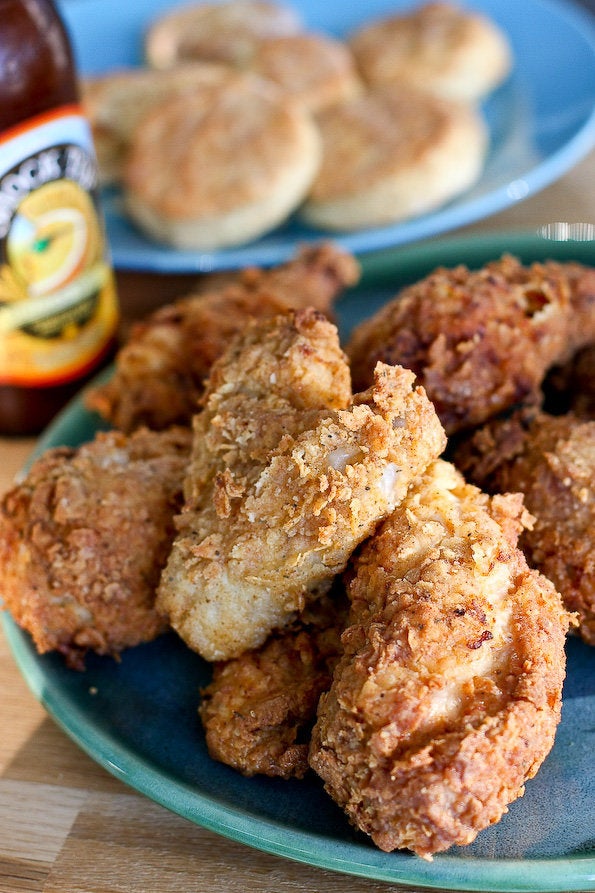In the world of Southern food, it doesn’t get any more iconic than fried chicken: It’s crispy and flavorful on the outside, moist and juicy on the inside. Preparation techniques and the right spice mix can make the difference between good and great fried chicken, so we’ve consulted some experts to share their top tips in the hopes of achieving fried chicken perfection at home.
Start with a brine ― preferably one with a buttermilk base.
For perfect fried chicken, “I always look for a golden crust that has been highly seasoned but the protein itself must be moist and juicy,” RJ Cooper, James Beard Award-winning executive chef and owner of Saint Stephen in Nashville, Tennessee, told HuffPost.
To achieve this, Cooper puts pieces of raw chicken in a buttermilk brine and refrigerates for 12 hours. His mixture contains buttermilk, fresh sage, rosemary, thyme and garlic.
“Brining the chicken keeps the bird moist and tender,” Cooper said. On the choice of buttermilk, he explains, “Buttermilk’s enzymes lend to a tender bird while instituting a fat component.” During the brining process, chicken is stored in a deep container with a weight and lid. (If you’re a fan of Samin Nosrat, you’ll remember she brines her roast chicken in buttermilk for 24 hours before cooking it.)
Don’t have buttermilk? Brine it in saltwater.
For Jon Buck, executive chef of Husk Greenville, “Perfectly fried chicken is all about crunchy skin with a balance of spices and of course, the juiciest, perfectly cooked dark meat.”
“Fried chicken is one of those dishes that needs to be prepped well in advance to achieve all the desired results,” Buck told HuffPost. At Husk, this process begins a minimum of 24 hours before chicken is fried.
“We use a 6% saltwater brine (1 cup salt to 1 gallon of water),” Buck said. “We hold our chicken in brine for 12 hours. I would say that the minimum time on brine is 8-10 hours, but do not exceed 12 hours.”

Buck explained that a saltwater brine both tenderizes and increases the natural flavor of the chicken through a gently controlled salinity. “It seems counterintuitive because it’s water, but saltwater pulls out moisture in the chicken, slightly concentrating the natural flavors while also seasoning the chicken all the way to the bone,” Buck said.
Buck doesn’t use buttermilk brine because even though it does tenderize the chicken, it also imparts the flavor of dairy and “tends to dilute the natural flavor of the chicken.”
“One could argue to use the two techniques in tandem,” Buck said. “Saltwater brine overnight and then marinate in buttermilk for an hour before dredging in the seasoned flour. It’s really a preference thing and perhaps the characteristics of the chicken being fried should play into the process as well.”
Don’t dredge your chicken in plain flour. Season it well.
“A great seasoned flour is crucial,” Cooper said. “I use AP flour, potato starch, corn starch, rice flour, tapioca flour, paprika, garlic powder and onion powder.”
Cooper uses this flour blend to make fried chicken because it results in a crispy coating. “This breading recipe was developed over the years at my days at Vidalia in DC,” he said. “We try not to lean away from what works.”
Let the chicken sit in its flour coating for MUCH longer than you’d think.
After brining, “the next important step is to allow the chicken to sit in seasoned flour for 12 hours, allowing the flour to become hydrated by the chicken, which creates the crust,” Buck said. The chicken is then dipped in a final dusting of seasoned flour before frying.
Cooper also has his chicken sit in its coating before frying, but the approach is a little different. Chicken is double coated in seasoned flour, egg wash and buttermilk and sits in this batter for one hour. “We let the batter sit on the chicken to adhere to the bird,” Cooper said.
Fry low and slow to make sure the chicken cooks through.
When making fried chicken, you want to cook at a high enough temperature that the outside crisps up, but not too quickly, as raw chicken and burnt skins are both no-gos.
“The trick is to fry the chicken at a low temperature, around 320 degrees Fahrenheit, for 14 minutes,” Buck said. “The lower temperature keeps the outside from burning before the inside is cooked through.” It’s important to note that he exclusively fries dark meat (never the breast), “so I can only speculate that the frying time should be increased by 2 or 3 minutes to insure that the larger breast is cooked all the way through.”
Use a deep cast iron pan.
For the purposes of cooking fried chicken (as well as more general cooking needs), Cooper recommends investing in a deep cast iron pan. It’s “traditional [and] holds heat extremely well,” he said.
Cooper fries chicken in an oiled, 4-inch high cast iron pan at 325 degrees. “Make sure to roll the chicken so it cooks evenly,” he said.
Listen for that sweet sizzle.
“Just make sure the grease is hot when the pieces are put in,” Andre Prince, owner of the iconic Prince’s Hot Chicken in Nashville, said with the confidence of someone with a decades-old family history of cooking fried chicken. “Fry it [at] a consistent [temperature]; don’t turn it up, don’t turn it down. Hear a little sizzle, then you know it’s gonna be right.”

Ever the keeper of her family’s secret recipe, when pressed for a specific cook time and temperature, Prince insisted, “You just go by the sound.”
As for her definition of perfect fried chicken: While she prefers her chicken naked (batter-free) these days, she’s found that people like fried chicken prepared in many different ways. “Different ways like different people, my goodness, nobody’s the same,” Prince said. One of her longtime customers, for example, likes her fried chicken “hard as a rock” and Prince obliges, cooking it for a longer period.
Finish with a drizzling of additional fats.
Go big or go home, right?
“You can just use canola oil for frying, but a pro tip is to use the ‘five fats’ (bacon, pork, ham, chicken and butter) as a drizzle on the chicken after it’s been fried,” Buck said. “Of course these are not always readily available for the home cook, but using only bacon fat drizzled over the finished fried chicken will get you close to the flavor you’re looking for.” Now there’s a reason to save your bacon grease.
“At Husk, we drizzle the five fats over our finished fried chicken, and then we dust the fried chicken with hot sauce powder right before serving,” Buck said.
